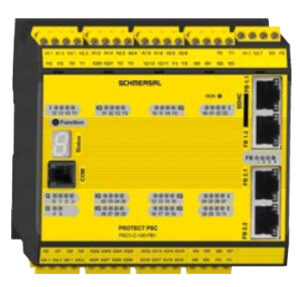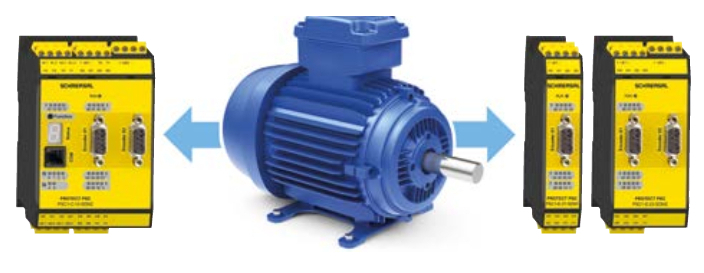SAFETY CONTROLLER WITH INTEGRATED AUXILIARY FUNCTIONS MONITOR AXES EASILY AND SAFELY

Drive technology and the safety of machinery go hand in hand: in addition to an integrated solution encompassing safe drive systems and PLCs, safe-ty mini-controllers like the Protect PSC1 from Schmersal also allow safety monitoring of drive-related parameters such as speed, acceleration, and position. Plus, thanks to communication modules, integration into the con-trol and management level is straightforward, including with OPC UA if re-quired.
Within mechanical engineering, the individual sub-disciplines of design are growing closer and closer together. This is a long-term trend, and affects drive technology in particular, which is closely associated with electrical and control technology. Most significantly though, it also affects the safety of machinery, where an ever-increasing number of functionalities are being shifted to the software.
Safety mini-controllers also capable of monitoring drive functions
In the case of more complex systems, the designer can make use of integrated complete solutions in order to link the drive technology with the process technology and machine safety.
In the case of manageable systems, this is not efficient, particularly when the effort required for software implementation is factored in. In this case, the use of safety mini controllers, such as the Protect PSC1 from the Schmersal Group’s range of control technology, offers an ideal solution.
Users of this safety controller, both manufacturers and operating companies of the machinery, can take advantage of a number of benefits, including scalability of the safety solution to the individual application or in terms of straightforward programming that requires no special knowledge to accomplish.
The Protect PSC1 is built as a modular system: two different basic modules (freely programmable compact controllers) are supplemented by a range of I/O expansion modules to adapt the controllers to the application. All in all, expansion modules can be connected to the basic module with as many as 272 inputs/outputs.
The range of expansion modules also includes a universal communication module that allows the PSC1 to be integrated into the higher- level automation level. Common fieldbus systems are available with just a single piece of hardware, which ultimately saves time and costs as it allows the safety solution to remain independent of the automation solution. In parallel, Ethernet SDDC enables safe remote I/O communication and safe cross- communication. The most recent controller version also integrates an OPC UA server.
Reliable axis monitoring of up to twelve axes
The traditional job of a safety controller is to monitor and activate safety switchgear devices and sensors. When compared to safety relay modules, the programmable controller offers features that include better adaptability to the individual requirements and conditions, with the aim of coordinating the protective devices to the specific use as optimally as possible, whilst also ensuring the highest level of productivity and safety. As an example, it is possible to link safety functions and to conveniently realise and individually program special-purpose operating modes such as setup mode or process monitoring.
The integrated axis monitoring function is of particular interest when it comes to drive technology: with the Protect PSC1, the user can monitor the safety aspects of as many as twelve axes in accordance with the requirements of DIN EN 61800-5-2.
Various safety functions for drive systems

The requirements of DIN EN 61800-5-2 are satisfied for all functions. Consequently, with the safety mini controller, the machinery manufacturer can easily monitor axes which, from the perspective of the machine safety, perform hazardous movements or must have their speed limited.
Application example: book binding machine
The benefits of linking the ‘traditional’ control tasks of the machine safety and safe axis monitoring are demonstrated by the example of a Protect PSC1 used in printing and processing machinery.
A manufacturer of book binding machinery manufactures machines whose working area or danger area is protected by a pair of safety hoods. The machine is set up, i.e., it is adjusted to the book formats in question, in inching mode with the guard door open. standard DIN EN 1010 (Safety of machinery – Safety requirements for the design and construction of printing and paper converting machines) requires that the operating speed of hazardous movements be limited to 1 m/min or 5 m/min, depending on the hazard.
In that case, the speed is captured by the speed measurement of two proximity switches on the chain wheel of the drive system. The Protect PSC1 processes the sensor signals and ensures safe monitoring of the axis speed.
An additional safety requirement relating to the axes in the danger area relates to the retraction of the clamping elements used to hold rolls of paper or sheet hold-down devices in place. The clamping elements may only be actuated in inching mode at a maximum speed of 5 m/min. This requirement is also easy to satisfy with the Protect PSC1, with no need for additional safe signal evaluation.
Integrated solution for two axes or separate modules
In the case of the ‘smaller’ version of the basic module (PSC1-C-10), safe axis monitoring is accomplished with a very compact, integrated solution. In that case, a controller can safely monitor either one or two axes with a single encoder system in each case. When it comes to monitoring up to twelve axes, the combination of larger PSC1-C-100 with expansion modules, which are available as single or twin-axis versions, is most suitable. Here, each axis can be safely monitored with one or two encoder systems.
The book binding machinery manufacturer referred to above realises safe axle monitoring with the compact basic module and uses the Safely Limited Speed/SLS, Safe Direction/SDL and Safely Limited Increment/SLI functions.
The ‘standard’ safety functions such as emergency stop and guard door monitoring can also be connected and processed.
This allows efficient implementation of the complete safety concept with just a single, space-saving assembly.


Author:
Dipl.Ing.Christian lumpe,
Product manager for Controllers,
K.A Schmersal Gmbh & Co.KG,Wuppertal
K.A Schmersal GmbH & Co.KG
Moddinghofe 30
42279 Wuppertal
Phone:+492026474-0
info@schmersal.com
www.schmersal.com



